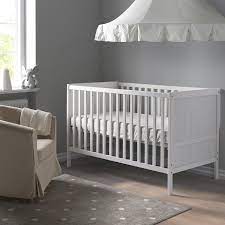Choosing the Perfect Crib for Your Baby: A Guide to Safe and Stylish Sleep Solutions

The History and Significance of the Crib
A crib, also known as a cot or cradle, is a bed specifically designed for infants and young children. It is an essential piece of furniture in many households, providing a safe and comfortable sleeping space for babies.
The history of the crib dates back centuries, with evidence of cradle-like beds being used in ancient civilizations such as Egypt and Greece. In medieval Europe, cribs were often elaborately carved and decorated, showcasing the craftsmanship of the time.
Today, cribs come in a variety of styles and materials to suit different tastes and needs. They typically have high sides to prevent the baby from rolling out and often feature adjustable mattress heights to accommodate the child’s growth.
Aside from its practical function, the crib also holds cultural significance in many societies. It symbolizes protection, comfort, and care for the youngest members of the family. In some cultures, cribs are passed down through generations as heirlooms, carrying with them memories and traditions.
As parents around the world prepare for the arrival of their newborns, choosing a crib is an important decision that reflects their values and priorities. Whether opting for a modern design or a vintage heirloom, the crib remains a timeless symbol of love and security for infants everywhere.
Top 5 Frequently Asked Questions About Crib Safety and Selection
- What are the safety guidelines for using a crib?
- How do I choose the right crib for my baby?
- Are there any regulations regarding crib design and construction?
- What are the recommended mattress types for cribs?
- How can I properly assemble and maintain a crib?
What are the safety guidelines for using a crib?
When it comes to using a crib, following safety guidelines is crucial to ensure the well-being of your baby. Some key safety tips include placing the crib away from windows, cords, and other hazards to prevent accidents. It is important to use a firm mattress that fits snugly within the crib frame and avoid using loose bedding or soft toys that could pose a suffocation risk. Additionally, regularly checking for any damaged or missing parts, ensuring proper assembly, and avoiding the use of drop-side cribs are essential practices to maintain a safe sleeping environment for your little one. By adhering to these safety guidelines, parents can create a secure and comfortable space for their baby to rest peacefully.
How do I choose the right crib for my baby?
When selecting the perfect crib for your baby, there are several key factors to consider. First and foremost, prioritize safety by ensuring that the crib meets current safety standards, with sturdy construction and proper spacing between slats to prevent entrapment. Look for adjustable mattress heights to accommodate your baby’s growth and make it easier to lift them in and out. Consider the style and design that best suits your preferences and nursery decor. Additionally, think about long-term usability, such as convertible cribs that can grow with your child. Finally, don’t forget to check reviews and recommendations from other parents to help guide your decision-making process. By taking these factors into account, you can choose a crib that provides a safe and comfortable sleeping environment for your little one.
Are there any regulations regarding crib design and construction?
Regulations regarding crib design and construction are in place to ensure the safety of infants and young children. In the United States, the Consumer Product Safety Commission (CPSC) sets strict guidelines for crib manufacturers to follow, covering aspects such as spacing between slats, mattress support, and overall structural integrity. These regulations aim to prevent accidents such as entrapment or falls, providing parents with peace of mind knowing that their child’s sleeping environment meets safety standards. It is important for consumers to be aware of these regulations when selecting a crib to help safeguard their little ones while they rest.
What are the recommended mattress types for cribs?
When it comes to choosing a mattress for a crib, safety and comfort are top priorities for parents. The recommended mattress types for cribs typically include firm, flat surfaces that fit snugly inside the crib frame to reduce the risk of suffocation or Sudden Infant Death Syndrome (SIDS). Many experts advise against using soft or memory foam mattresses, as they can pose a suffocation hazard. Instead, breathable and hypoallergenic materials are often recommended to promote safe and restful sleep for infants. Prioritizing the right mattress type ensures that babies have a secure and supportive sleeping environment in their cribs.
How can I properly assemble and maintain a crib?
Assembling and maintaining a crib is essential for ensuring the safety and comfort of your baby. When assembling a crib, carefully follow the manufacturer’s instructions step by step to guarantee that it is put together correctly. Make sure all parts are securely fastened and that there are no loose screws or pieces that could pose a hazard to your child. Regularly inspect the crib for any signs of wear or damage, such as loose bolts or cracked wood, and promptly address any issues to maintain its structural integrity. Additionally, keep the crib clean by wiping it down regularly with a damp cloth and avoiding harsh chemicals that could damage the finish. By properly assembling and maintaining your crib, you can create a safe and cozy sleeping environment for your little one.